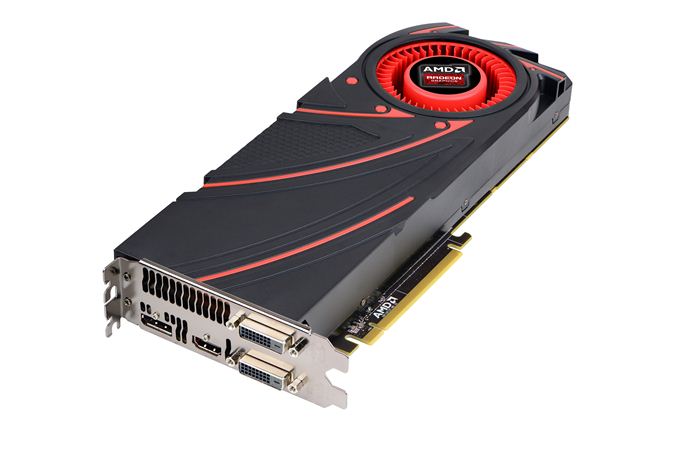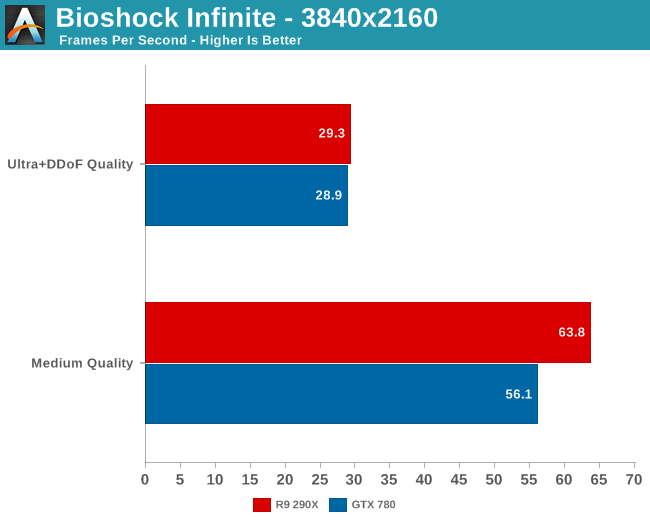AMD Radeon R9 290X Performance Preview: Bioshock Infinite
by Ryan Smith on October 17, 2013 3:00 PM EST- Posted in
- GPUs
- AMD
- Radeon
- Hawaii
- Radeon 200

As something of a counter-event to NVIDIA’s gaming showcase taking place in Montreal, Canada this week, AMD has organized an early, brief reveal of their forthcoming Radeon R9 290X video card. The card won’t be launching until sometime in the future, but for today we’re being allowed to confirm that we have the card and are being allowed to publish a single benchmark: Bioshock Infinite at 3840x2160 (4K).
AMD has purposely kept the public details on the R9 290X sparse so far, so we know little other than that it’s a larger GPU rated for 5 TFLOPS of compute performance, and paired with 4GB of memory for a total memory bandwidth of over 300GB/sec. Like most segments of the consumer electronics industry AMD has been gearing up for 3840x2160 (4K) displays, so the Radeon 290X is AMD’s flagship card geared towards gamers using 3840x2160 or 2560x1440 monitors.
Consequently AMD is seeking to draw attention to their 4K performance with today’s benchmark reveal. AMD named the game, the cards, and the resolution – Bioshock at 4K against the GTX 780 – so this is a very limited subset of our full results. And as with all controlled benchmark releases we’d advise not reading too much into any single benchmark here, as the relative performance of NVIDIA and AMD cards changes with the game being tested, at times rather wildly..

The biggest problem with 4K displays for at least the intermediate future, other than price of course, will be that you’re either going to need a lot of GPU power to drive them or will have to take a quality hit to achieve acceptable performance. Neither the R9 290X nor the GTX 780 are powerful enough to stay above 30fps on Bioshock with everything turned up. For that you will need to drop down to Medium quality, which gets performance past 30fps and up into the 60fps range. The fact that we’re even talking about playing a game at 60fps this high of a resolution – with 2.25 times as many pixels as 2560x1440 – is a big accomplishment right there, it’s just not one that will come without tradeoffs. For little-to-no compromise 4K gaming we’ll undoubtedly need to turn to multiple GPUs and Crossfire/SLI.
Moving on, it’s interesting to note in this case that both cards are essentially tied at Ultra quality, but when we dial down to medium the 290X takes a very decisive 14% lead. At the highest quality settings we should be shader/texture bound due to the significant use of shader effects on Bioshock’s highest quality settings, whereas at lower quality settings at least some of the bottleneck will shift to elements such as ROP throughput, memory bandwidth, and the geometry pipeline.
Wrapping this preview up, we’ll have more details on the 290X in the near future. AMD has made it clear that they are aiming high with their new flagship video card, so it will be interesting to see what they can pull off as we approach Tahiti/7970’s second birthday.













89 Comments
View All Comments
Elixer - Thursday, October 17, 2013 - link
Was this on a win 7, 8, or 8.1 system?Also, you ever get a response from AMD about them dropping Vista driver support ?
Ryan Smith - Thursday, October 17, 2013 - link
Windows 8.1http://www.anandtech.com/show/7400/the-radeon-r9-2...
Flunk - Thursday, October 17, 2013 - link
So it's slower than a Nvidia GTX Titan then, interesting but it gives us an idea of what it will cost.marc1000 - Thursday, October 17, 2013 - link
kinda disappointed too. not that the card is in my budget anyway, but I was hoping for a little more...Brutalizer - Friday, October 18, 2013 - link
I am curious to see how much improvement Mantle API will give. Will Mantle give 25% more performance? Or 50%? But as one AMD rep said in an official interview "we will ridicule Titan when using Mantle", it seems that Mantle will give far more than 25% improvement. Because 25% more improvement is not "ridiculous". How much is "ridiculous" you think? 100%? 200%? 1000% would certainly be ridiculous. But 25% not.Frallan - Tuesday, October 22, 2013 - link
In marketing speak it means anything above tied lets say around 2%...In engineeringspeak Id say it starts at 50+%
So just have a look at who said it is he marketing or engineering?
tuklap - Wednesday, October 23, 2013 - link
they sometimes exaggerate things. for us, 10-15% improvement is not that good. but for the designers, its excellent for them. we dont know what lies behind those numbers soo better just wait and appreciateDa W - Thursday, October 17, 2013 - link
So effectively tying 780 at max detail while R9 280X was lagging by a wide margin. (in fact bioshock seems to favor nvidia cards).Not bad. I need to see price still.
Hey Ryan are you able to include R9 270X in crossfire in your nexts benchmark? Seems to me that Pitcairn is the most power efficient chip, and with price, could be a nice option for eyefinity rigs (with GPU#2 shutted down while in simple desktop mode). I know i know about crossfire issues.
nathanddrews - Thursday, October 17, 2013 - link
Does it favor NVIDIA? I dunno...http://www.anandtech.com/bench/GPU13/702
I can't wait to see some objective reviews. Didn't Roy just call out the Titan the other day? If you're not royally handing the 780 its ass, you probably shouldn't taunt ye olde Titan...
Spunjji - Friday, October 18, 2013 - link
Graphs are funny things - different ones say different things:http://www.anandtech.com/bench/GPU13/704
To be honest I'd say that the game doesn't especially favour either side strongly, but there seems to be a marginal lean towards the nVidia architecture.